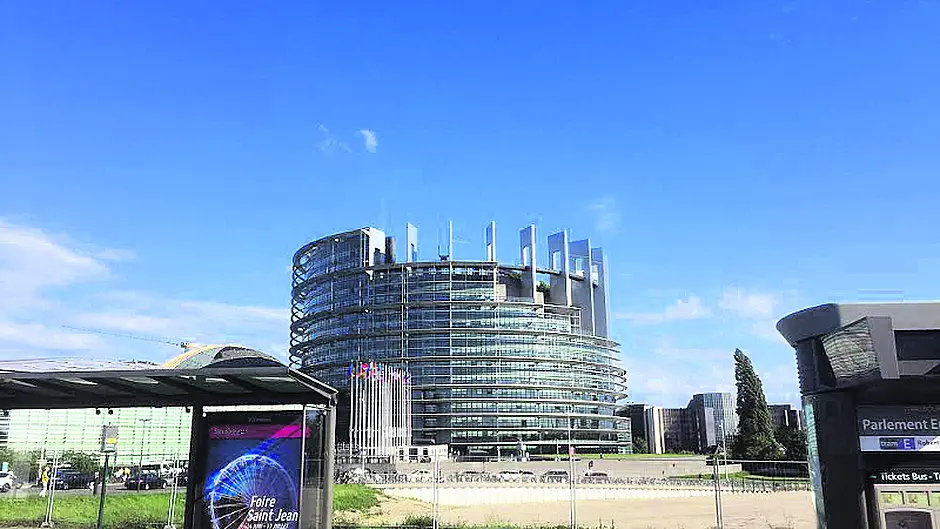After the shock of Brexit, reporter Kieran O’Mahony’s fact-finding visit to the European Parliament in Strasbourg proved to be a timely one
THE mechanics of how the EU operates may seem daunting to most European citizens.
In fact, that was one of several reasons cited by some MEPs when asked why the British public voted to exit the Union.
They pointed out that there is a sense of detachment as to how the political process works, and many felt so far removed from it, that they’d rather be in than out.
On a recent trip to Strasbourg, organised by the European Parliament Office in Ireland, journalists from all over Ireland were invited to attend a regional media seminar to get a better understanding of how the operation of the Parliament.
Sitting in Strasbourg once a month, these plenary sessions last over four days in the Parliament’s building, located in the ‘European Quarter’ of the city.
Plenary sessions bring together all the MEPs and are the busiest time in the life of the European Parliament.
This is where committees and political groups present the results of their work and it is only during the plenary sessions that the MEPs – the only EU representatives directly elected by the citizens of the 27 member states – participate in decision-making.
With security very tight within the building, we were given press accreditation by our guide and allowed to sit in the press area of the ‘Hemicycle’ – the large circular chamber where all the MEPs sit and debate issues for that particular session.
The highlights of these particular sessions were, naturally, the continued debate on Brexit, as well as discussions on setting-up a common European Border and Coast Guard. Headphones were provided to allow us to listen to the debates and take notes.
It’s a pretty intimidating place for the uninitiated, with so many MEPs all clamouring to have their say. It was interesting to see that the members of the Parliament sit in political groups, rather than by their nationalities.
There are currently eight political groups in the Parliament and 25 members are needed to form a political group. The group of the European People’s Party (EPP) is the largest political group in the European Parliament and brings together the centre-right pro-European political forces from the member states. This group includes Irish MEPs Brian Hayes, Mairead McGuinness, Deirdre Clune and Sean Kelly.
The Group of the Progressive Alliance of Socialists and Democrats in Europe (S&D) brings together the Socialist, Social Democratic and Labour Parties in the EU and includes Irish MEP Nessa Childers.
Independent MEP Marian Larkin is a member of the Group of the Alliance of Liberals and Democrats for Europe (ALDE), while Bandon’s Brian Crowley – who is currently in hospital recuperating after surgery – is a member of the European Conservative and Reformists (ECR), which was founded after the June 2009 election.
The only other group containing Irish MEPs is the Confederal Group of European United Left/Nordic Green Left (GUE/NGL) and has Lynn Boylan, Liadh Ní Riada, Luke ‘Ming’ Flanagan and Matt Carthy among its members.
As part of our itinerary, we also got to meet most of the Irish MEPs for a Q&A, although Luke Flanagan was noticeable by his absence. This proved to be very interesting in hearing first-hand how the members operate in what seems like such a complicated process. Brexit was, of course, the hot topic and each MEP was frank about what they thought would happen next.
We also got a brief meeting with EU Commissioner ‘Big’ Phil Hogan, who took time out to meet the group before rushing off to Amsterdam for a conference. He spoke about the importance of the agricultural food and drink sector in Ireland and the fact that 41% of all of these agricultural exports go to Great Britain, so Brexit has huge potential repercussions for us.
Later, a tour of the impressive audio visual services in the Parliament, revealed a number of Irish-born staff. The studios are used by all radio and television broadcasters from around Europe.
Irish woman Karen Coleman from ‘EP radio’ also met us to explain her role as a broadcaster within the parliament.At the end of the unexpectedly long day, we were all keen to grab some fresh air outside the Parliament.
But getting out of the high security building proved to be as tricky as getting in, especially when we couldn’t find any ‘exit’ signs!
Thankfully after much searching and (slight) panicking, we bumped into Maria, the audiovisual press officer, who kindly led us to the nearest exit and into the bright evening sunshine of Strasbourg.









